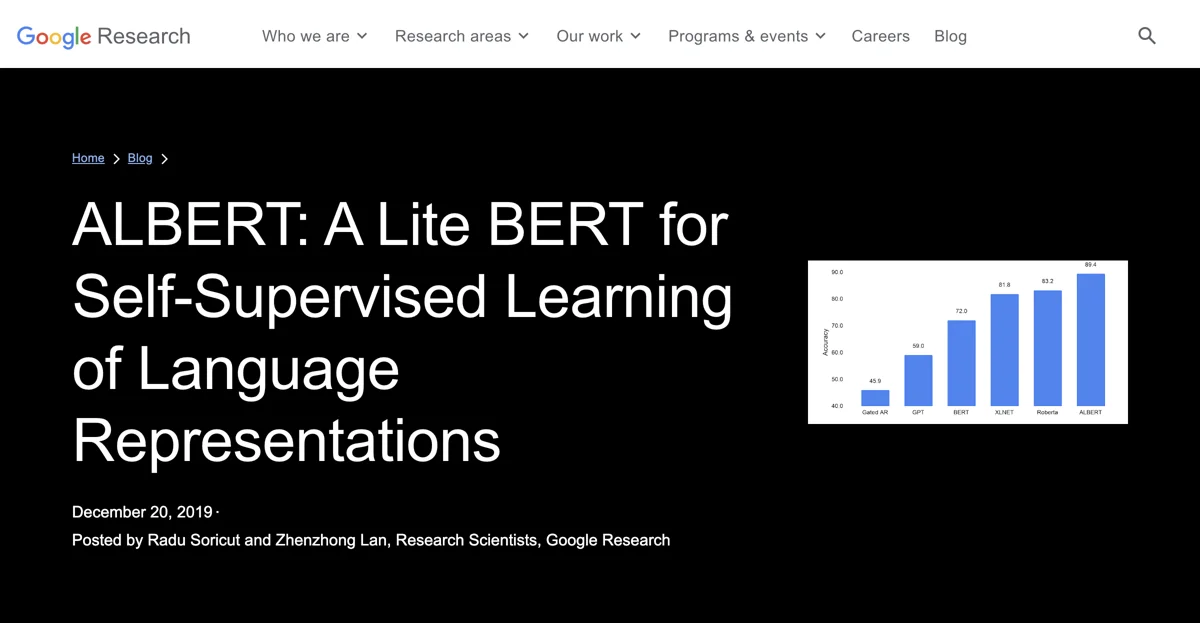ALBERT is an upgrade to BERT that has made significant advancements in the field of natural language processing (NLP). Since the emergence of BERT, NLP research has adopted a new paradigm, leveraging large amounts of text for self-supervised model pretraining without the need for data annotation. ALBERT aims to improve upon this approach by understanding the factors that contribute to language-understanding performance. The key to ALBERT's design is to allocate the model's capacity more efficiently. It achieves this through factorization of the embedding parametrization, which splits the embedding matrix between input-level embeddings with a relatively low dimension and hidden-layer embeddings with higher dimensionalities. This results in an 80% reduction in the parameters of the projection block with only a minor drop in performance. Another critical design decision is to eliminate redundancy by parameter-sharing across layers. This approach slightly reduces accuracy but leads to a more compact model size. Implementing these two design changes together yields an ALBERT-base model with a significant parameter reduction while still achieving respectable performance. Moreover, by scaling up the size of the hidden-layer embeddings, ALBERT can achieve even better results. The ALBERT-xxlarge configuration demonstrates significant performance gains on benchmarks like SQuAD2.0 and RACE. The success of ALBERT highlights the importance of identifying and focusing on the aspects of a model that give rise to powerful contextual representations, which can greatly improve the model's efficiency and performance on a wide range of NLP tasks. Google is open-sourcing ALBERT to the research community to facilitate further advancements in the field.

ALBERT
ALBERT is an advanced AI for self-supervised language learning, improving NLP performance and available as open source.

Top Alternatives to ALBERT
Boba
Boba is an AI-powered ideation tool that assists with research and strategy
Wiseone
Wiseone is an AI-powered tool that boosts web search and reading productivity
Project Knowledge Exploration
Project Knowledge Exploration is an AI-powered research platform that offers in-depth exploration
Runway
Runway is an AI-powered creativity tool for various media
Notably
Notably is an AI-powered research platform that boosts efficiency
PaperBrain
PaperBrain is an AI-powered research tool that simplifies access
Unriddle
Unriddle is an AI-powered research tool that saves time and simplifies tasks
Journey AI
Journey AI converts customer research into actionable journey maps
genei
genei is an AI-powered research tool that boosts productivity
Replio
Replio is an AI-powered research platform that streamlines interviews and analytics
Layer
Layer is an AI-powered research tool that saves time
Iris.ai RSpace™
Iris.ai RSpace™ is an AI-powered workspace for smarter research
Fairgen
Fairgen is an AI-powered research tool that offers granular insights
Towards Data Science
Towards Data Science offers diverse AI-related content and insights
NewsDeck
NewsDeck is an AI-powered newsreader that helps users discover, filter, and analyze thousands of articles daily.
Locus
Locus is an AI-powered smart search tool that enhances productivity by quickly finding relevant information on any web page using natural language.
Encord
Encord is an AI-powered data development platform that accelerates data curation and labeling workflows for computer vision and multimodal AI teams.
Seeker
Seeker is a secure, retrieval-augmented generation AI chat platform that provides trustworthy insights from large data sets.
AIModels.fyi
AIModels.fyi is an AI-powered platform that curates and summarizes the latest AI research papers, models, and tools, helping users stay informed about significant AI breakthroughs.
22Analytics
22Analytics is an AI-powered market research platform that helps users validate ideas and analyze competitors efficiently.
Grably
Grably offers instant access to highly-specific, labeled datasets for AI training, enhancing model accuracy with diverse real-world data.